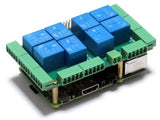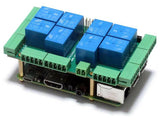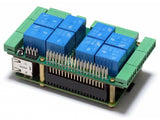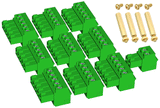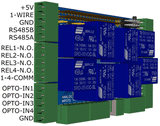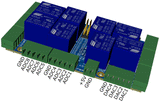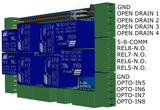FEATURES
- Home Automation V4 8-Layer Stackable HAT for Raspberry Pi
- Eight relays with status LEDs and and N.O contacts
- Eight 12-bit A/D inputs, 250 Hz sample rate, 0-3.3V
- Four 13-bit DAC outputs (0-10V dimmers)
- Four PWM 24V/4A open-drain outputs
- Eight optically isolated digital inputs
- Contact closure/Event counters up to 500 Hz
- Four Quadrature Encoder inputs
- 26 GPIOs from Raspberry Pi available
- 1-WIRE and RS485 communication ports
- Pluggable Connectors 26-16 AWG for all ports
- On-board hardware watchdog
- On-board resettable fuse
- Reverse power supply protection
- Brass stand-offs, screws and nuts included
- Hardware self-test with loop-back cable
- Open source hardware, schematics available
- 32-bit Processor running at 64MHz
- Uses only I2C port (address 0x28..0x2f ), all GPIO pins available
- Works with any Raspberry Pi from ZERO to 5
- ECCN Code EAR99
- Command line
- Python Library
- Node-RED Nodes
- Domoticz Plugin
- OpenPLC example PSM integration
- Arduino Library
- Firmware Update
- CODESYS Driver
- OpenPLC module
- Home Assistant Integration
3D FILES
HOME AUTO HAT 3D STEP MODEL DOWNLOAD
HOME AUTO HAT WITH RASPERRY PI STEP MODEL DOWNLOAD
DESCRIPTION
Raspberry Pi HOME AUTOMATION HAT
Latest news:
The Home Automation HAT uses only pluggable connectors. In addition, the latest release (V4.0 and up) has two new communication ports: 1-Wire and RS485.
The card uses only 5V power. On-board step-up power supply generates 12V to power the 0-10V analog outputs.
A general purpose push-button, wired directly to a Raspberry Pi GPIO pin, can be used to shut down Raspberry Pi without a keyboard, or to force any output to a desired state.
Ideal solution for your Raspberry Pi HOME AUTOMATION projects. Read temperatures in up to 8 zones with analog inputs. Control your heating and cooling system with the 8 onboard relays. Use the 8 optically isolated digital inputs for your security system. Activate the hardware watchdog to monitor and power cycle the Raspberry Pi in case of software lockup. Control four-light systems with the four PWM open-drain outputs (you supply external power up to 24V). Control four light dimmers using 0-10V outputs.
COMPATIBILITY
The card is compatible with all Raspberry Pi versions from Zero to 5. It shares the I2C bus using only two of the Raspberry Pi’s GPIO pins to manage all eight cards. This feature leaves the remaining 24 GPIOs available for the user.
POWER REQUIREMENTS
The Home Automation card needs 5V to operate and can be powered from Raspberry Pi or from its own pluggable connector. The onboard relay coils are also powered from the 5V. An on-board 5V to 12V step-up power supply generates the voltage to drive the 0-10V analog outputs. A local 3.3V regulator powers the rest of the circuitry. The card needs 50mA to operate with all relays off. Each relay needs up to 80 mA to turn on.
RELAYS
The 8 on-board relays have contacts brought out to heavy duty pluggable connectors, which make the card easy to use when multiple cards are stacked up. Relays are grouped in two sections of four relays each, with one common terminal and one N-O contact for each relay. Relays are rated 10A/24VDC and 250VAC, but due to the board geometry limitation, the relays can switch only 3A and 24V, AC or DC. You can switch large loads of up to 8A and 240VAC using our 4-RELAY cards, which also adds four extra inputs.
Status LEDs show when RELAYS are ON or OFF.
STACKING MULTIPLE CARDS
Up to eight Home Automation cards can be stacked on your Raspberry Pi. Each card is identified by jumpers you install to indicate the level in the stack. Cards can be installed in any order. The three position jumper on the upper right corner of the card selects the stack level.

For your convenience, two jumpers are provided with each card.
CARD PINOUT

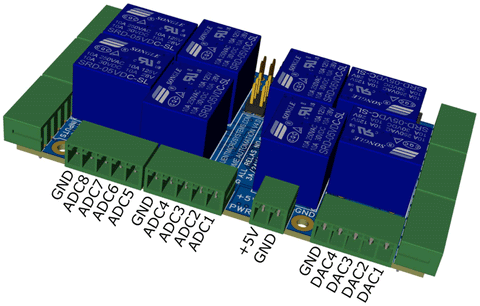
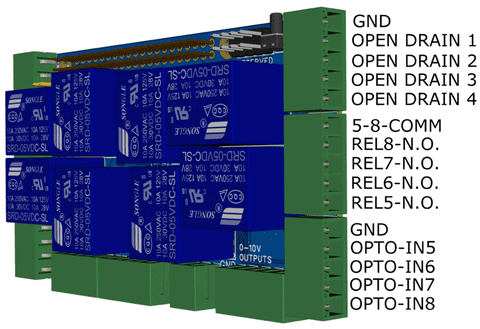
ELECTRICAL SPECIFICATIONS
- Power supply: Pluggable Connector, 5V/3A
- Power consumption: 50mA (all relays off), 700mA (all relays on)
- On board resettable fuse: 3A
- Open Drain outputs: maximum 3A, 24V
- Relays 1,2,3,4,5,8: N-O contacts, 6A/24VAC or DC
- Relays 6,7: 3A/24VAC or DC
- Analog Inputs:
- Maximum input voltage: 3V
- Input Impedance: 50 KΩ
- Resolution: 12 bits
- Sample rate: 250 samples/sec.
- DAC Outputs:
- Resistive load: Minimum 1 KΩ
- Accuracy: ±1%
- Opto-isolated Digital Inputs:
- Input Forward Current: Typical 5 mA, maximum 50 mA
- Input Series Resistor: 1K
- Input Reverse Voltage: 5V
- Input Forward Voltage: 25V @ 10 mA
MECHANICAL SPECIFICATIONS
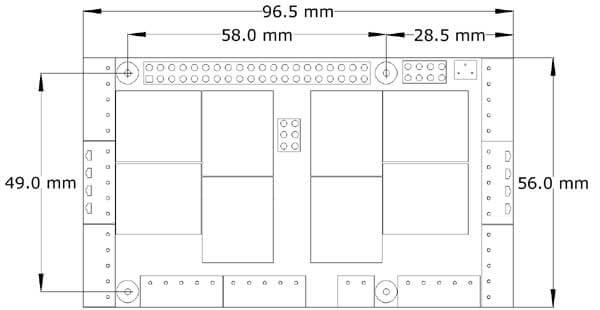
DOWNLOADS
SOFTWARE
SOFTWARE INTERFACES
You can write your own application using the Command Line , Python Libraries or Arduino Library provided. No programming is required if you use the Node-Red nodes we supply. You can drag-and-drop the functional blocks to design your application. Examples are provided at GitHub.
TESTING THE RELAYS
Without the loopback cable and with no loads connected to the relays, run the command relay_test. Relays will cycle on and off in sequence and the corresponding LED's will turn on and off.
FIELD CALIBRATION
The analog inputs and outputs are calibrated from the factory with 1% precision. Field calibration up to 0.1% can be obtained using a precision voltage meter. Calibration instructions coming soon.
FIRMWARE UPDATE
The card firmware can be updated in the field by running a command. The update is made with the latest firmware version located on our servers. More instructions about the process can be found on GitHub. Please make sure there is no process, like Node-Red or python scripts, that tries to access the card during the update process.
WATCHDOG
The Home Automation card contains a built-in hardware watchdog which will guarantee that your mission-critical project will recover and continue running even if Raspberry Pi software hangs up. After power up the watchdog is disabled, and becomes active after it receives the first reset.
The default timeout is 120 seconds. Once activated, if it does not receive a subsequent reset from Raspberry Pi within 2 minutes, the watchdog cuts the power and restores it after 10 seconds.
Raspberry Pi needs to issue a reset command on the I2C port before the timer on the watchdog expires. The timer period after power up and the active timer period can be set from the command line. The number of resets is stored in flash and can be accessed or cleared from the command line. All the watchdog commands are described by the online help function.
ACCESSORIES
SELF TEST CABLE
Groups of three inputs and outputs can be self-tested with the help of a LOOPBACK CABLE. The cable can be purchased as an accessory to the card, or you can make it yourself using three of the connectors provided with the kit.

SELF TEST CABLE SCHEMATIC

1. TEST the GPIO and OPTO-INPUTS 1-4
In versions 4.0 and up, the GPIO pins on the upper left side connector have been replaced with an RS485 port and 1-Wire interface. Thus, Test#1 is no longer available.
2. TEST the ANALOG INPUTS and OUTPUTS
Insert the cable on the bottom side of the card, as shown in the following picture, and run the self-test command.

3. TEST the OPEN DRAIN OUTPUTS and OPTO-INPUTS 5-8
Insert the cable on the right side of the card, as shown in the following picture, and run the self-test command.

DIN-RAIL MOUNTING
The Home Automation card can be installed parallel on a DIN-Rail using the DIN-Rail Kit Type 1, or perpendicular using the DIN-Rail Kit Type 2.
SMART FAN
The Smart Fan provides a stackable cooling solution for Raspberry Pi. Its on-board processor powers the fan just enough to maintain the preset temperature of the Pi.
BREAK-OUT BOARDS
Break-out boards provide a convenient and robust way of accessing the IO pins. For screw-mount wiring you can use the Break-Out Kit Type 1. The Break-Out Kit Type 2 provides wiring with pluggable connectors.
YOUR KIT
When you purchase the Home Automation Card you will receive the following items:
1. Home Automation Stackable Card for Raspberry Pi
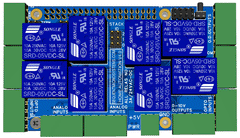
2. Mounting hardware
- Four M2.5x18mm male-female brass standoffs
- Four M2.5x5mm brass screws
- Four M2.5 brass nuts
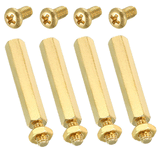
3. Two stack level jumpers

4. All required connector plugs
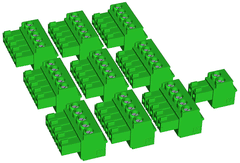
QUICK START
- Plug your card on top of your Raspberry Pi and power up the system
- Enable I2C communication on Raspberry Pi using raspi-config.
- Install the software from github.com:
- ~$ git clone https://github.com/SequentMicrosystems/ioplus-rpi.git
- ~$ cd /home/pi/ioplus-rpi
- ~/ioplus-rpi$ sudo make install
- ~/ioplus-rpi$ ioplus
The program will respond with a list of available commands.










